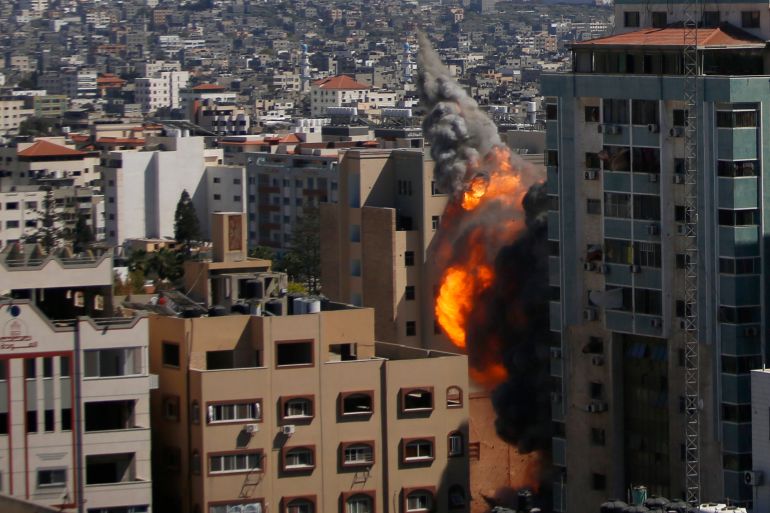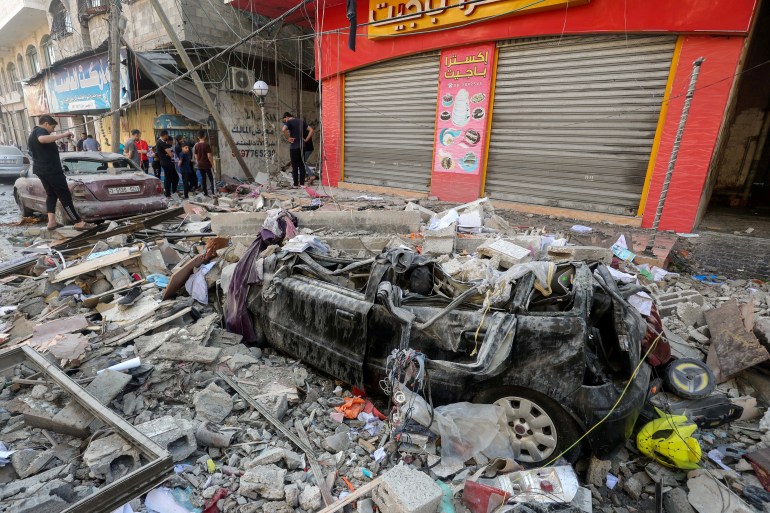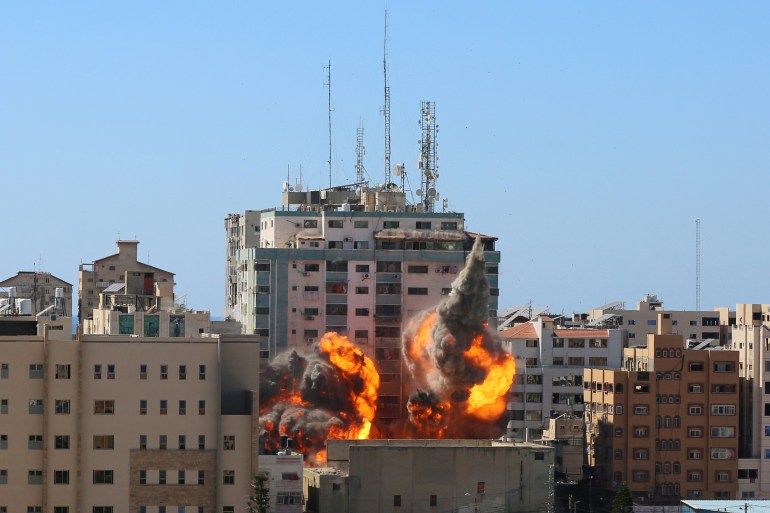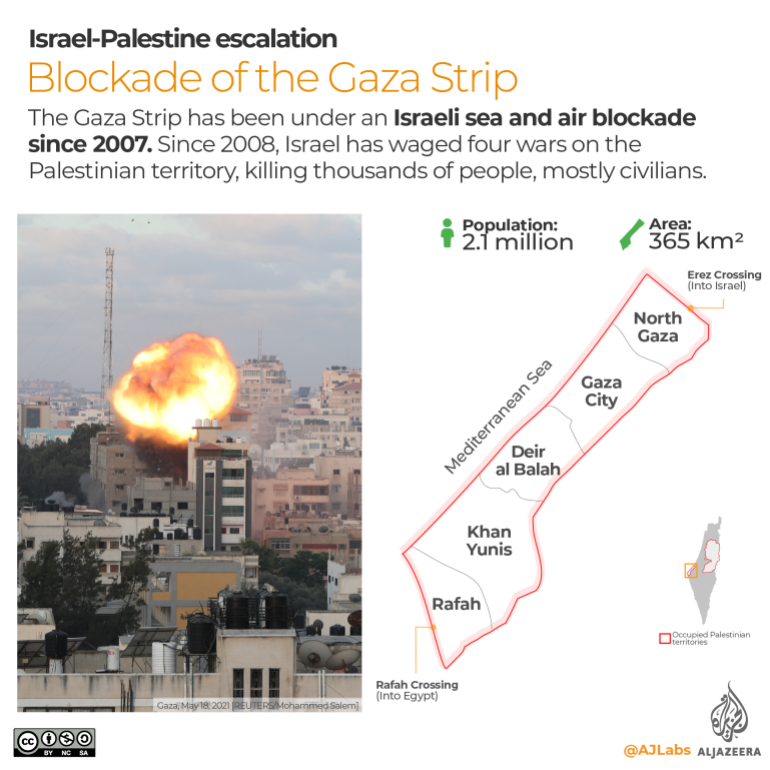What is behind Israel’s targeting of prominent buildings in Gaza?
Israel’s attacks on Gaza’s civilian buildings are an attempt to demoralise Palestinians and weaken their resolve.

Rami Aldraimli watched in disbelief as the building he had worked in for more than 20 years came crashing down.
Following a missile “warning”, Israeli fighter jets late on Tuesday afternoon bombed al-Awqaf building, the latest structure to be targeted by Israel during its relentless 10-day offensive on the besieged Gaza Strip.
Keep reading
list of 3 items‘Huge loss’: Experienced Gaza doctors killed in Israeli attacks
Pogba, Diallo hold up Palestine flag at Manchester United match
The five-storey building in western Gaza City housed a number of offices, including of Mashareq, one of Gaza’s oldest and most prominent media production firms.
“It wasn’t just a company,” Aldraimli, Mashareq’s 43-year-old executive director, said. “It’s a dream I’ve been working on, building it up until we had 60 employees.”
قصف مبني يضم شركة مشارق للدعاية والاعلان ومكتبة لبيع القرطاسية في خطوة لتدمير الاقتصاد الفلسطيني #Gaza_Under_Attack #GazaUnderAttack #غزة_تحت_القضف pic.twitter.com/VYH7jyphPE
— حسين الخطيب | Hussein Khateib (@huseinalkhateib) May 17, 2021
Translation: The bombing of the building that includes the Mashareq Advertising Company and a stationery shop, in a move to destroy the Palestinian economy.
Established in 1999, the company grew to offer advertising and photography services, as well as film production and sound engineering.
“Popular singer Mohammed Assaf, before he became famous, recorded in our studios many times,” Aldraimli recalled, proudly. “The place was a dream for many people to work with us,” he said. “We were like a family.”
The impact of the building’s destruction, he added, extended beyond the material losses, which are nonetheless significant given the expensive equipment inside the office.
“It’s not about the money,” Aldraimli said. “It was a place to work, hang out at and build memories. It was about the space we created for ourselves. Money can be compensated, but decades of our work as well as our personal memories lost in the rubble cannot be.”
في لحظة بلمح البصر دمر الإحتلال الصهيوني مقر عملي ومصدر رزقي ورزق عشرات العائلات شركة مشارق أكبر وأقدم شركة للتجهيزات والإنتاج والدعاية والإعلان في قطاع #غزة حسبنا الله ونعم الوكيل https://t.co/tlueuR2Aiq
— Tamer Hamam (@itamer83) May 17, 2021
Translation: In the blink of an eye, Israel destroyed my place of work, my income, the income of dozens of families. They destroyed Mashareq, the oldest and biggest production and advertising company in Gaza.
Scale of targeting civilian areas
According to Gaza’s ministry of government information, six high-rise buildings – all iconic city landmarks – have been flattened by Israeli fighter jets since the bombardment began on May 10. They are part of the more than 184 residential and commercial properties that have been destroyed, including buildings that housed 33 media institutions.
On Saturday, an Israeli air raid demolished al-Jalaa tower, which hosted many residential apartments and offices, including the bureaus of Al Jazeera and The Associated Press. As in other cases, Israel justified the bombing of the building by claiming it housed military assets of Hamas, the group running the Strip. It has failed, however, to provide any evidence to back up its claim, while press freedom advocates have denounced the attack as a brazen attempt to “silence” journalists covering Israel’s deadly bombardment on the besieged enclave.
At least 227 Palestinians, including 64 children, have been killed and more than 1,500 others wounded, in what observers say has been Israel’s harshest targeting of civilian areas in the enclave to date. At least 72,000 people have been displaced, the United Nations said, with the majority seeking protection in 58 UNRWA schools across Gaza.
At least 12 people have died in Israel in rocket fire from Gaza.
Furthermore, the Israeli targeting of vital infrastructure has affected water, sanitation and hygiene services for hundreds of thousands of people.

Mohsen Abu Ramadan, a political and economic analyst, said the Israeli strategy of bombing civilian areas and infrastructure is not new.
“We’ve seen it in previous offensives, but the scale of targeting civilians this time in the Gaza Strip is much higher,” he told Al Jazeera, arguing that the support of the United States and the European Union and the “incompetence” of Arab leaders enabled Israel to implement such a tactic.
In the deadliest single attack yet, Israeli air raids on Sunday killed 42 people, including 10 children and 16 women – all families buried under the rubble of their flattened homes in al-Wehda Street, an upscale, lively area in the heart of Gaza City.
“In most cases, civilians are not even warned to evacuate their homes and workplaces, so this Israeli propaganda of sending a warning as a humanitarian gesture before it gets targeted is nonsense,” said Abu Ramadan.
The Israeli army has acknowledged its bombardment has resulted in “unfortunate unintended civilian casualties” but Abu Ramadan said the objective behind attacks such on al-Wehda Street was to create discontent and to turn people against the actions of the armed groups in Gaza.
“These targets, which have directly affected civilians immeasurably, are aimed to damage the reputation of the armed groups by creating a gap between them in terms of support,” Abu Ramadan said. “Driving Palestinians to demand these groups to stop firing rockets at Israel means a loss of popular support, and that is what Israel is banking on.”
Determination and resolve amid ‘disfiguring of Gaza’
Yet that does not seem to be the case, said Yahya al-Sarraj, mayor of Gaza City’s municipality, who stressed that Palestinian support for a ceasefire is not mutually exclusive to absolving Israel and blaming the armed groups.
“The vast number of civilian deaths and heavy damages incurred upon the Gaza Strip is a desperate attempt to demoralise the steadfastness and strong will of our people,” al-Sarraj told Al Jazeera.
“But from walking around and meeting with many people – especially those who lost their homes or members of their families – what stood out for me was their determination and resolve,” he said. “They know this offensive is not just a war on Gaza, but an extension of Israeli occupation policies in the occupied West Bank and Jerusalem,” he added.
The conflict began following escalations in occupied East Jerusalem, after protests by Palestinians against what activists slam as Israel’s settler-colonialism policies in the Sheikh Jarrah neighbourhood and violent incursions by Israeli police into Al-Aqsa Mosque compound during the last days of Ramadan.
The Israeli attacks on Gaza – one of the most densely populated areas in the world, with more than two million people living in a territory that is 41km (25 miles) long, and 6-12km (3.7 to 7.5 miles) wide – have targeted streets and areas close to hospitals, obstructing the movement of ambulances and civil defence vehicles in reaching and transporting the wounded.
Telecommunication lines, electricity grids, sewage systems and water pipelines have also been bombed. Beachside cafes, factories, commercial stores, charity centres and vocational institutes have not been spared, either.
The total material cost so far is estimated at about $322.3m, according to local officials.
Al-Sarraj said the targeting of facilities such as the Foamco mattress factory and Matouk ice cream factory is clearly intended at further weakening the economy of the Strip, which has been under a devastating blockade since 2007.
“These acts by the Israeli occupation are directed to make the youth feel even more despair and hopelessness, especially when they see their work or companies that they have created all disappear,” al-Sarraj added, calling the attacks organised and systematic.
At the same time, bombing landmarks such as the al-Jalaa and Shorouq buildings – which housed many international and local media agencies – is designed to “disfigure the city beyond recognition and to prevent showing the world the reality of this violent offensive”.
‘Photogenic bombing’
Gideon Levy, a columnist at the Israeli daily Haaretz, said the bombing of high-rise buildings, in particular, make for a spectacular show on television, buoying an Israeli public opinion that is already very supportive of the offensive on Gaza.
“The towers that were bombed were a great show,” Levy told Al Jazeera. “It’s the only scene that the Israeli television channels are broadcasting again and again.”
“The towers collapsing is something that is very photogenic,” he added. “It shows how strong Israel is, and how Israeli pilots are so sophisticated by taking down a whole tower by one or two missiles.”

For Levy, however, this constant drip feed showcasing such destruction smacks of “a sign of weakness”.
“It’s a loss of strength,” he said. “Israel was always proud it could target a certain room in a certain apartment on a certain floor and bomb it. But Israel does it because it can, and has nobody to stop it from doing so.”
Israelis know very little about Gaza, he continued, and are perfectly happy with not knowing anything about it.
“The images and reports they see from Gaza don’t include the suffering,” Levy explained.
“This is done deliberately, not because of censorship. Everyone shares the same denial. We all don’t want to see it and the media is helping us not to see it by not showing it to us.”
Rising from the ashes

Back in Gaza, al-Sarraj said the determination and resolve of Palestinians is as strong as ever.
“The young people are always trying to find new creative ways to lift themselves out of these crises,” he said, pointing out that the symbol of Gaza City is the phoenix, “the mythical bird that rises from the ashes stronger than before”.
“Gaza is already starting to emerge from the rubble and destruction and return to life.”
For Aldraimli, every Israeli attack unites the Palestinians even more.
“My 76-year-old father was killed on May 12 when he was on his way to pray,” he said. “Now I’ve lost my company. These are very heavy blows, but what is keeping me together, what is strengthening my resolve, is the unity shown by Palestinians across the territories, especially in Jerusalem.”
Aldraimli already his eyes set on returning to work.
“From the first day the building was destroyed, dozens of people and companies have been offering us their own offices so we can continue our work,” he said.
“It’s been heartening to see, and proves that Israel cannot erase our memories.”